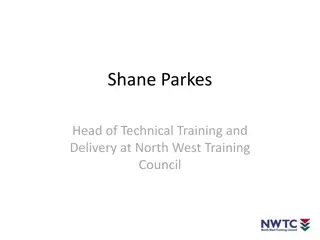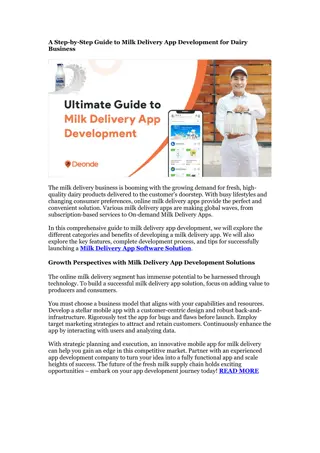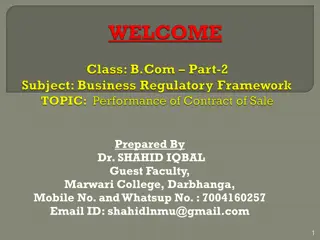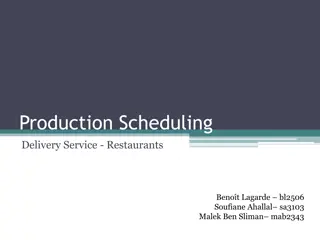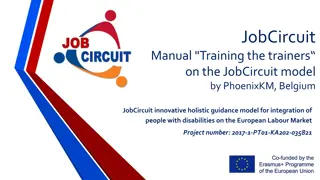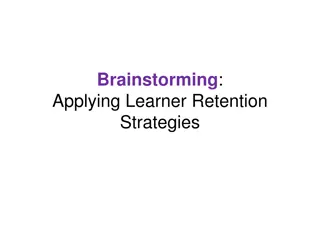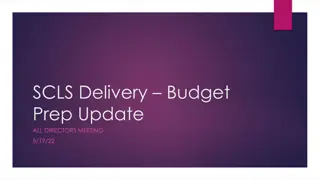Effective Training Delivery: Key Considerations and Strategies
Effective training delivery requires understanding learning styles, adult learning principles, presentation skills, group interaction, audience needs, evaluation methods, and train-the-trainer techniques. Training should involve unlearning old knowledge, relearning new information, and engaging participants actively. Emphasizing the nature of training, setting course topics, imparting subject knowledge, and fostering empathy are crucial. Incorporating cognitive, affective, and psychomotor aspects, aiming for behavior change, addressing different learning styles, and combining teaching methods are key to successful training.
Download Presentation

Please find below an Image/Link to download the presentation.
The content on the website is provided AS IS for your information and personal use only. It may not be sold, licensed, or shared on other websites without obtaining consent from the author. Download presentation by click this link. If you encounter any issues during the download, it is possible that the publisher has removed the file from their server.
E N D
Presentation Transcript
The following should be considered for effective training delivery: Learning styles. Adult learning principles. Presentation and facilitation skills. Effective group interaction and communication skills. Meeting the needs of a specific audience. Evaluation of training and its effectiveness. Train the trainer 2
Trainees possess knowledge and skills All these are not right So aim should be: First unlearn some of the existing info/knowledge Then relearn new things/knowledge Train the trainer 3
Understand nature of training Fix location, time and number of days Course/topics that to be covered Methods or techniques to be adopted To impart subject knowledge Maintain Interest in them Active involvement of participants Train the trainer 4
To create aim, purpose and values To create empathy To update them about the necessity of financial literacy nationally and internationally Train the trainer 5
1. Cognitive Remember 2. Affective Receiving 3. Psychomotor Imitation Understand Responding Manipulation Apply Valuing Precision Analyze Organization Articulation Evaluate Characterization Naturalization Create Train the trainer 6
Change in Behavior Change in Behavior Knowledge Attitude Skill Train the trainer 8
Three primary styles are: Auditory Auditory Visual Visual Kinesthetic Kinesthetic Train the trainer 9
Everyone learns in all styles; however, each person has one dominant learning style. Visual learners absorb more from material they see, Auditory learners from lecture they hear, Kinesthetic learners from doing or performing a task. So ToT trainers should follow a combination of styles of teaching/training Train the trainer 10
Visual learners prefer seeing or reading material. These learners respond well to pictures and illustrations of the material. So your presentations/training materials need to have pictures as well as written directions. Visual learners often prefer reading, seeing a play or paintings.. Train the trainer 11
Auditory learners like to hear presentations or discuss problems. Lecture is typically an effective learning method for these participants. Audiotapes are also a good learning tool for these participants. Typically, auditory learners like to talk These individuals learn from talking, teaching, reading out loud and presenting. Train the trainer 12
Kinesthetic learners absorb new information by doing, moving and participating. These trainees like action and are bored by just reading or listening. They are usually not good at learning from audiotapes or lectures. If they have to sit too long without moving they lose their attention. Kinesthetic learners respond well to group activities with a variety of activities. Some examples of how they might learn include: writing the answers. simulating the skill, like practicing a presentation. Train the trainer 13
Assessment Should also Satisfy Learning Styles of Students!! Train the trainer 14
Session One: Introduction Overview: Introduces the Training course curriculum, purpose, objectives and Structure. It gives participants and trainers an initial opportunity to get to know each other and sets the tone for the rest of the course. It should create a welcoming and stimulating learning environment. Introducing the Audience/Know your A-u-d-i-e-n-c-e Analysis - Who are they? How many will be there? Understanding - What is their prior knowledge? Demographics - What is their age, sex, background? Interest - Why are they there? Who asked them? Environment - Where will I stand? Can they all see? Needs - What are their needs? Customized - What specific needs to address? Expectations - What do they expect to learn or hear? Train the trainer 15
After the icebreaker, officially welcome everyone to the course and introduce theaudience as the first of two important reference points that trainers should be focused on as they develop and deliver a course. This is an opportunity to comment on the participatory nature of this training and to explain that participants and trainers alike will be each other s audience in the days to come. The getting to know each other process continues with individual introductions. Train the trainer 16
Introduce objectives as the 2nd key reference point for financial literacy training design and delivery. Facilitate a brief discussion about why objectives are important. Accountability Relevance to Trainers Invite participants to articulate their personal objectives for the course Then turn to the course objective and explain how the training is structured to facilitate achievement of that objective. Train the trainer 17
Identify whether and how their investment objectives can be met in the context of the course. Relate to prior knowledge Try to get attention Train the trainer 18
Plan sessions, hours in each day/session, and days of training program Prepare slides for Trainers (participants) From easy to harder For each subject/idea Presentation Demonstration Hands on practice Ask them to prepare slides for their trainees based on your (Trainers ) one. Train the trainer 19
There are two types of speakers, those that are nervous, and those that are Liars . (Mark Twain) Prepare Positive self-messages Attitude towards yourself, teaching, material, audience 9 P s Prior Proper Preparation Prevents Poor Performance of the Person Putting on the Presentation. Train the trainer 20
Breathing Articulation Volume Variety Common Voice problems Train the trainer 21
Total body as a communication vehicle Eye Contact Facial expression Dress Gestures Hands and Arms Train the trainer
Logical flow Every point leads to the next. Connect the points. Explain the details Use simple words. Use graphics when needed. Use Examples/what happened with some capital market participants Refer to Handouts. Ask questions. Don t read from slides. Train the trainer 23
Always tell the truth!!! If you don t know the answer, promise to re- search. Get back to trainee with answer. Answer directly. Stay on track, brief and to the point. Refer to your speech. Helps reinforce & clarify presentation. Train the trainer 24
Involve participants. Acknowledge/appreciate their (trainees ) ideas. Don t get personal - be objective. Don t give in to personal attackers - stick to the facts. Enlist other trainees help if it is disruptive to them as well. Train the trainer 25
Conduct the seminar in Bangla, English can be used but need to be translated properly Distribute free of cost the standard published materials He shall not make any monetary gain by any means. Maintain all records including the details of workshop and participants, etc. in the manner, as may be specified by BSEC and provide to BSEC as and when desired. Train the trainer 26
Trainers not to Indulge on selling or promoting any specific investment product Promote commercial interest of any intermediary or issuer Undertake any securities market related business activity Engage in any activity which has potential to bring disrespect to regulator Train the trainer 27
You may use (and therefore be able to demonstrate) the following methods: 1. Lecture 2. Demonstration 3.Case Study 4. Small Group Tasks/exercise 5. Readings 6. Stories 7. Brainstorming 8.Individual Exercises 9. Q&A session Train the trainer 28
Dont give new information. Only review points. Review process/steps. Relate back to your introduction. When summarizing a module, show where it fits in the big picture. Train the trainer 29
THANK YOU Train the trainer 30





